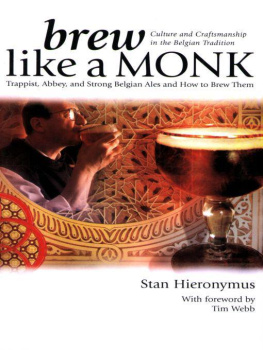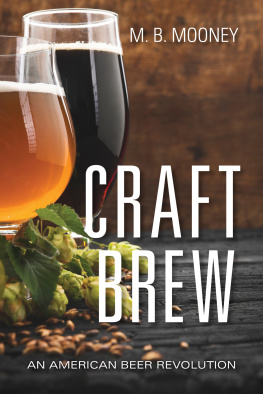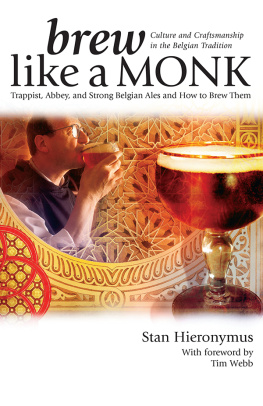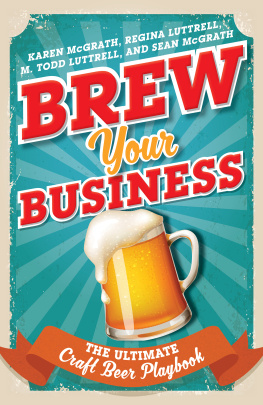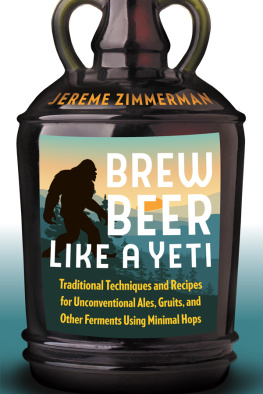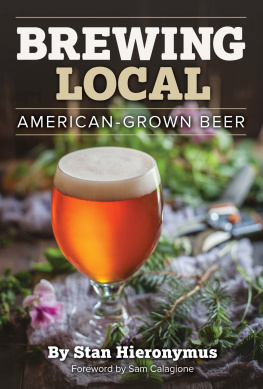Table of Contents
Brewers Publications
A Division of the Brewers Association
PO Box 1679, Boulder, Colorado 80306-1679
www.beertown.org
All rights reserved. No portion of this book may be reproduced in any form without written permission of the publisher. Neither the author, editor nor the publisher assume any responsibility for the use or misuse of information contained in this book.
Printed in the United States of America.
10 9876543
ISBN-13: 9780937381878
ISBN-10: 0-937-381-87-X
Library of Congress Cataloging-in-Publication Data
Hieronymus, Stan.
Brew like a monk : Trappist, abbey, and strong Belgian ales and how to brew them / Stan Hieronymus.
p. cm.
ISBN 0-937381-87-X
1. Beer. 2. Brewers--Religious life--Belgium--History. 3.
Brewers--Religious life--United States--History. 4.
Trappists--Spiritual life. 5. Cookery (Beer) I. Title.
TP577.H54G 2005
663.42088255125--dc22
2005020617
Publisher: Ray Daniels
Technical Editor: Randy Mosher
Copy Editor: Daria Labinsky
Index: Daria Labinsky
Production & Design Management: Stephanie Johnson
Cover and Interior Design: Julie Lawrason
Cover Illustration: Alicia Buelow
Cover Photo, Brother Lode Orval: Owen Franken
Photos: Stan Hieronymus
To Saint Benedict and all the monastery brewers he inspired.
Acknowledgements
M y long list of people to thank begins with those on the ground in Belgium: Derek Walsh, Yvan De Baets, and Joris Pattyntheir guidance kept me from getting hopelessly lost. Derek provided most of the important data for tables that allow us to strip search (his words) the Trappist beers, as well as many images. I also would have been lost without Tim Webbs Good Beer Guide to Belgium & Holland (CAMRA, 2002) and thank him for the Foreword as well. Several importers helped me work with Belgian brewers but especially Dan Shelton and Craig Hartinger, without whose help the following pages would be short essential information. No book was more valuable than Jef van den Steens Les Trappistes: Les Abbayes et Leurs Bieres (Editions Racine, 2003), which offers details about Trappist brewing history and current practices that nobody else has reported, as well as spectacular photos.
Everybody who writes about beer owes a serious debt to Michael Jackson, more serious still when it comes to the beers of Belgium. By writing about them nearly thirty years ago thats when Schlitz was a top-selling beer in Americahe provided a history we wouldnt otherwise enjoy. I also owe triple thanks to Ray Daniels, because he suggested I write this book, then kept me on track, and because Designing Great Beers (Brewers Publications, 1996) provided clues about how to organize it. Along those lines, thanks to Gordon Strong for two presentations aimed at homebrewers, one titled Designing Great Dubbels, Everything You Wanted to Know About Belgians But Were Afraid to Ask Ray, that helped me get my bearings when it came to approaching this family of beers.
Brock Wagner, founder of Saint Arnold Brewing Company in Houston, Texas, has said, Ive come to realize I may own the stock, but its not my brewery. It belongs to everybody who drinks Saint Arnold beer. I should write the same of this book. I assembled it, but the book belongs to hundreds of commercial and amateur brewers who provided the information youll find here. I thank them and apologize in advance to those whose names dont get listed. I raise a glass to every brewer quoted in this book and every one who took the time to contribute.
Basically, I thank everyone who went out of their way to keep me from looking stupid. For instance, Siebel Institute of Technology and World Brewing Academy put both volumes of Jean De Clercks essential A Textbook of Brewing (Chapman & Hall, 1957) in the mail when I needed them, and Anheuser-Busch sent a book from its corporate library. Many brewers, even those inside monastery walls, took the time to exchange multiple e-mails and clarify important details.
Along those lines, particular thanks go to Randy Mosher, not just for books I consulted often when writing this one, but for material I otherwise would not have found and for being the last line of defense when it came to technical matters.
I reserve the most special thanks for my wife, Daria, the best copy editor a wayward beer writer could want, a perfect beer traveling companion, and the woman who encourages me to pursue sometimes frivolous endeavors. Also thanks to our children, Sierra and Ryan, for being generally inspiring.
Foreword by Tim Webb
I used to live in an area of south-west England called the South Hams. The area is east of Plymouth, where the Pilgrim Fathers stocked up the Mayflower on its journey from Holland to the New World. It is a place of ancient villages and holiday homes, snuck between the moorland of Sherlock Holmes Hound of the Baskervilles and the coastal creeks where Sir Francis Drake lay in wait for the Spanish Armada.
When I moved there my first task, obviously, was to locate the best of the local pubs. Finding them was easy enoughit is an area blessed with the best of the breed-but remembering which was which was more difficult. The reason was that so many were called by the same name, the Church House Inn. I recall there were ten, unrelated in business.
It was not until a decade later, when researching the second edition of the Good Beer Guide to Belgium, that I realized what these venerable places had in common. They had all been hostelries that had graced the front gates of long-dead abbeys, priories, and monasteries.
I had learned of such places at junior school, from the redoubtable Colonel Gethin. A crusty old survivor of the war in Mesopotamia in 1916, the Sixties saw Gethin teaching History and General Knowledge in the British Midlands. His style was to replace the curriculum with a boiled-down version of his own experiences of life. Condemned to be ignorant of official history, we were instead inspired to understand what makes the world as it is.
The Colonels take on Christianity was that it was a great force, for good and evil. Taking monasteries as the best example of this, he told us they were places of scholarship and learning, in much the same way as modem universities. Yet, equally, they were despised as hotbeds of political intrigue and influence, usually of a most unchristian variety.
Yet they got away with their reputations intact, in this version of history at any rate, because they provided good lodgings! just as the populace forgave Mussolinis fascistic barbarism because he made the trains run on time.
People of taste and influence have always been smart travelers. In the centuries before Lonely Planet, well-informed travellers knew that the best lodgings were at the inns run by abbeys. Plain but clean rooms, fellowship, bread, cheese, fresh produce, and, of course, ale, a speciality of monks throughout the centuries.
The fact that the tradition of brewing abbeys survives until the twenty-first Christian century is a testament to its association with high quality. That its survival is currently limited to the kingdom of Belgium and to the Cistercian Order of the Strict Observance, or Trappists, is more a quirk of history.
Monastic brewing is known to have existed as far back as the sixth century. Saint Benedict, on whose rules the whole monastic system is based, encouraged abbeys to contribute to their local community. On public health grounds alone, brewing beer was a noble act. In times of water-borne epidemics, the boiling of beer during brewing made it a far healthier option than the towns water supply.

